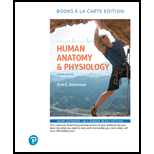
Mark the following statements as true or false. If a statement is false, correct it to make a true statement.
a. The heart is located in the mediastinum slightly to the left of the midline.
b. The heart consists of two superior ventricles and two inferior atria.
c. Arteries always carry oxygenated blood away from the heart, and veins always carry deoxygenated blood toward the heart.
d. The pulmonary circuit delivers blood from the right side of the heart to the lungs to become oxygenated.
e. The heart plays a role in the regulation of blood pressure and secretes the hormone atrial natriuretic peptide.
To review:
Whether the following statements are true or false. Also, the false statements are to be corrected.
a. The heart is located in the mediastinum, slightly to the left of the midline.
b. The heart consists of two superior ventricles and two inferior atria.
c. Arteries always carry oxygenated blood away from the heart, and veins always carry deoxygenated blood toward the heart.
d. The pulmonary circuit delivers blood from the right side of the heart to the lungs for it to be oxygenated.
e. The heart plays a role in the regulation of blood pressure and secretes the atrial natriuretic peptide hormone.
Introduction:
The heart is situated on the left side of the thoracic cavity. It consists of four chambers: two atria and two ventricles. Pumping of oxygenated blood away from the heart and carrying deoxygenated blood back is the main function of the heart.
Explanation of Solution
a. The statement,“The heart is located in the mediastinum, slightly to the left of the midline” is true. The mediastinum is a subdivision of the thoracic cavity, located between the two lungs. It not only houses the heart, but also the blood vessels, trachea, andesophagus. The heart lies in the cavity of the mediastinum, and is called the pericardial cavity.
b. The statement, “The heart consists of two superior ventricles and two inferior atria” is false. The heart has four chambers, which include the two ventricles and the two atria. The left and right atria lie superior while the left and right ventricles lie inferior. So, the correct statement is “The heart consists of two superior atria and two inferior ventricles”.
c. The statement, “Arteriesalways carry oxygenated blood away from the heart, and veins always carry deoxygenated blood toward the heart” is true. The pulmonary arteriesare known to carry deoxygenated blood to the lungs for it to be oxygenated, and, in the systemic circuit, arteries deliver oxygenated blood to the systemic capillaries. The veins of the pulmonary circuit deliver oxygenated blood to the left side of the heart, while the veins (of the systemic circuit) deliver deoxygenated blood toward the heart and away from the body.
d. The statement, “The pulmonary circuit delivers blood from the right side of the heart to lungs to become oxygenated” is true. The pulmonary pump is located on the right side of the heart. It pumps blood into a series of blood vessels that directs it to the lungs. The pulmonary arteries deliveroxygen-poor and carbondioxide-rich, or deoxygenated, blood to the lungs to make it oxygenated.
e. The statement, “The heart plays a role in the regulation of blood pressure, and secretes the atrial natriuretic peptide (ANP) hormone” is true. The heart also acts as an endocrine organ. ANP decreases the concentration of sodium ion retention in the kidney and lowers the blood pressure. This reduces the osmotic water retention and also helps in reducing the pressure and volume of blood in the blood vessels.
Thus, it can be concluded that the heart lies in the mediastinum. It consists of two inferior ventricles and two superior atria. Thearteries are responsible for carrying oxygenated blood away from the heartand toward the tissues. Also, veins are responsible for carrying deoxygenated blood towards the heart.
Want to see more full solutions like this?
Chapter 17 Solutions
Human Anatomy & Physiology, Books a la Carte Edition (2nd Edition)
- Not part of a graded assignment, from a past midtermarrow_forwardNoggin mutation: The mouse, one of the phenotypic consequences of Noggin mutationis mispatterning of the spinal cord, in the posterior region of the mouse embryo, suchthat in the hindlimb region the more ventral fates are lost, and the dorsal Pax3 domain isexpanded. (this experiment is not in the lectures).a. Hypothesis for why: What would be your hypothesis for why the ventral fatesare lost and dorsal fates expanded? Include in your answer the words notochord,BMP, SHH and either (or both of) surface ectoderm or lateral plate mesodermarrow_forwardNot part of a graded assignment, from a past midtermarrow_forward
- Explain in a flowcharts organazing the words down below: genetics Chromosomes Inheritance DNA & Genes Mutations Proteinsarrow_forwardplease helparrow_forwardWhat does the heavy dark line along collecting duct tell us about water reabsorption in this individual at this time? What does the heavy dark line along collecting duct tell us about ADH secretion in this individual at this time?arrow_forward
 Medical Terminology for Health Professions, Spira...Health & NutritionISBN:9781305634350Author:Ann Ehrlich, Carol L. Schroeder, Laura Ehrlich, Katrina A. SchroederPublisher:Cengage Learning
Medical Terminology for Health Professions, Spira...Health & NutritionISBN:9781305634350Author:Ann Ehrlich, Carol L. Schroeder, Laura Ehrlich, Katrina A. SchroederPublisher:Cengage Learning Fundamentals of Sectional Anatomy: An Imaging App...BiologyISBN:9781133960867Author:Denise L. LazoPublisher:Cengage Learning
Fundamentals of Sectional Anatomy: An Imaging App...BiologyISBN:9781133960867Author:Denise L. LazoPublisher:Cengage Learning





